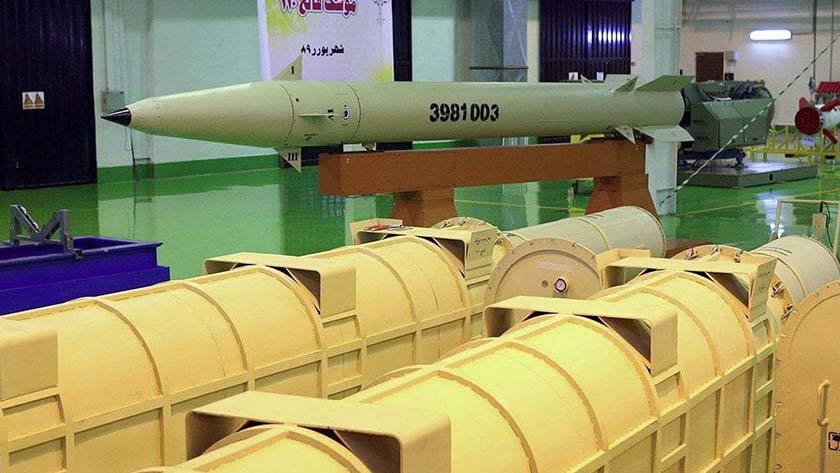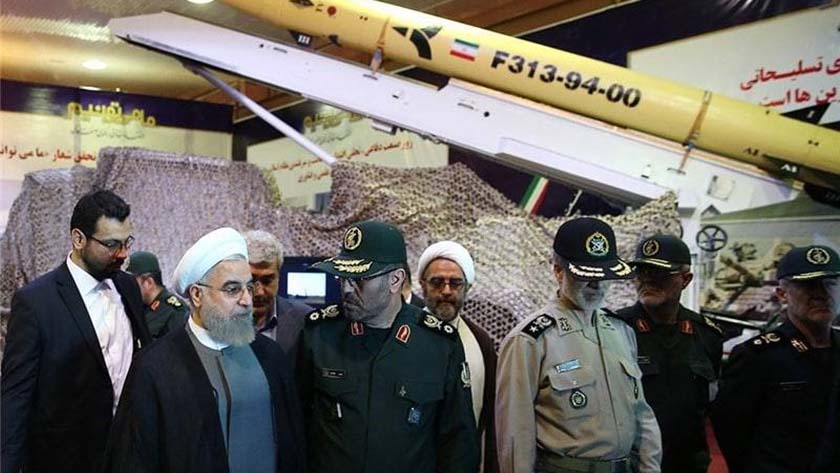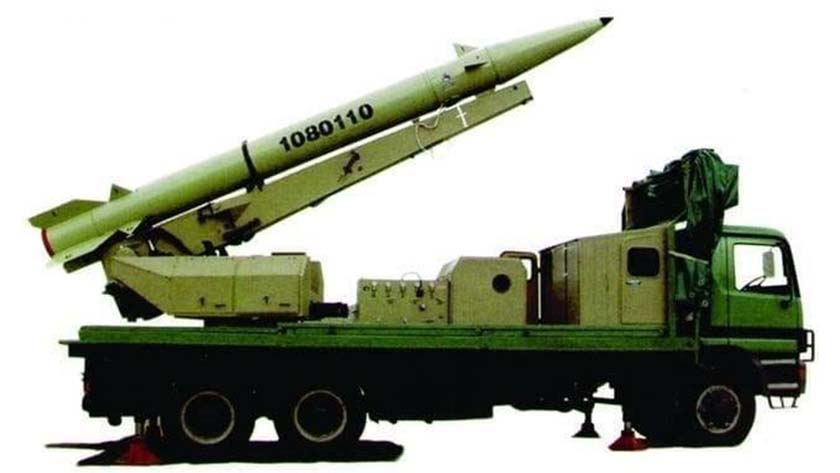Iran Press/ Iran news: Martyr Eslami was in charge of this project, which led to the creation of a product with a range of 170 km and a heavier warhead than "Iran-130" and Oghab (Eagle).
This rocket was tested in the last months of the imposed war, and its effects on the enemy's front were interesting. But the most important effects of this rocket, later called "Zelzal", were revealed a little more than a decade later.
After the end of the imposed war, the development of "Nazeat" and "Zelzal" missiles continued and a diverse family was formed in terms of range, type of fuel and some other things, and various units of the IRGC and the army used it.

Related News:
How capable are Iran's missiles?
Development
Iran's most famous short-range tactical missile, named "Fateh 110," was made by making extensive modifications on the Zelzal missile. The combination of the body and thruster of the Zelzal and the guidance system of another missile called "Tondar 69" (ground-to-ground model of the Chinese HQ2 air defense missile) led to the construction of a missile with a range of more than 200 km, but with the ability to guide to the end of the path.
This would multiply the operational value of Fateh 110 compared to Zelzal. More than 5 million man-hours of research, design, simulation, construction and testing were carried out by several industries of the Ministry of Defense, prominent industrial universities of the country and some other research and industrial departments to build a native guidance system and combine it with propulsion of Zelzal rocket to produce a missile capable of being guided to the end of the path and with good and reliable accuracy. Fateh 110 was built to replace the Zelzal missile.

Related News:
Zolfaqar ballistic missile; symbol of speed, precision in hitting target
Innovation
In 2002, Iran practically entered the club of countries with solid-fuel missiles by testing a new missile. "Fateh 110" was the name of a missile that was made by the aerospace industries of the Ministry of Defense and Armed Forces Support and introduced Islamic Iran into a new field of missile production.
The construction and mass production of such missiles of different types surprised many missile experts. The use of solid fuel in ballistic missiles has several important properties.
A ballistic missile or any other type of missile, in order to be able to fly, needs the ignition of fuel so that the rocket moves forward with the ignition of the fuel and the exit of the burnt gases from the last part of the missile, i.e. the engine.
In this rule, the lighter the missile is, the faster it will be, but in the case of heavy missiles, which are often long-range, newer and more up-to-date engines are used for greater acceleration.
In addition, the use of solid fuels instead of old liquid fuels increases the ignition time of the fuel, and with the increase of the ignition time, the range of the missile and even at fixed ranges, the speed of the missile increases significantly. Currently, usually in the missile and military industries, most of these rockets are powered by solid fuel, but in the case of satellite rockets and spacecraft, liquid fuel is mostly used.

Related News:
Fakour air-to-air missile; result of Iranian creativity
Characteristics
The Fateh 110 missile is based on the Zelzal-2 rocket and is actually a guided type with a Zelzal-2 control system.
Fateh 110 missile is very similar to the Zelzal missile, but in terms of accuracy of hitting the target, Fateh 110 missile is much more accurate than the Zelzal rocket.
Fateh 110 missile is a pinpoint missile with an error of fewer than 10 meters, which is one of the most important features of this missile.
This missile has a length of 8850 mm, a diameter of 6610 mm, a weight of 3325 kg and a warhead of 450 kg. This missile is one of the Iranian guided ballistic missiles, which is one of the other distinguishing features of Fateh 110 with Zelzal missiles.
Fateh 110 uses inertial guidance and uses additional technologies in missile guidance.
Fateh 110 has a single-stage engine and operates from the ground to the ground and is able to target fixed land and sea targets, enemy gathering points, command centers, missile sites, ammunition dumps, radars and other desired targets. Fateh 110 missile has a fixed triangular bulk at the end of the missile and 4 moving bulk at the head, which are responsible for changing the direction and guiding the missile.
One of the characteristics of Fateh 110 is that with the native technology used in this missile, it is impossible to identify the missile at the time of launch and the missile can be easily controlled by its navigators until the moment of impact.

Related News:
Qadr missile; symbol of achieving new missile capabilities
Different types
In the early 2000s, the first generation of the Fateh 110 missile was unveiled. The range of the first generation of this missile was declared to be about 200 km, but a few years later, the second generation of this missile was operationally tested, a generation that improved the range and optimized the control and navigation systems among its changes compared to the first generation. The third generation of the Fateh 110 missile was unveiled at the end of the 2000s and had an increase in range of about 50 kilometers compared to the second generation.
In 2002, the fourth generation Fateh 110 ballistic missile with mixed solid fuel was unveiled, which has a longer range than the previous types. Increasing the range of this missile to more than 300 kilometers and targeting any kind of weather conditions are two important components of the fourth-generation Fateh 110.
The aerospace industry of the Ministry of Defense has begun to mass produce the fourth generation of this missile, which has the ability to destroy any target with precise accuracy and high speed.
High operational speed due to the reduction of the launch site support systems, increasing the life of the missile, increasing the deployment time of the armed missile on the launch platform for timely firing, reducing the time of pre-launch and during launch tests, reducing the time to leave the launch site and not requiring short-term periodic visits are among other capabilities of the fourth generation of this missile.
With the upgrade of the Fateh 110 ballistic missile, this missile is able to target and destroy the land and sea targets, enemy gathering points, command centers, missile sites, ammunition dumps, radars and other desired targets. Currently, Fateh missiles can fire in two types of fixed and mobile launchers (car mounted).

Related News:
Soumar؛ Iran’s first ground cruise missile
Fateh 313 missile
Fateh 313 is a new member of the Fateh missile family, which was unveiled in 2016 and at the same time as Defense Industry Day. Fateh 313 has the longest range among the Fateh missile family and is able to target its targets at a distance of more than 440 kilometers. Its weight is 3245 kg, its length is 8756 mm, its diameter is 612 mm and the weight of its warhead is 380 kg.
Unlike the previous 4 types that use solid fuel, this missile uses "composite solid fuel".
The way this type of fuel works is that in the end part of the rocket where the combustion chamber and fuel are located, unlike normal solid fuels, the fuel is mixed with an oxidizing agent and finally a combination of fuel and oxidizing agent starts to burn in the form of small crystals and with its ignition, the rocket starts moving.
One of the most important advantages of using this type of fuel is to create more stability during the rocket's flight, because in the case of solid fuel rockets, there are usually many instabilities during the rocket's flight due to various reasons in the rocket's combustion.
The Ministry of Defense has not published any news about the use of special technology in the motor body of solid fuel rockets, but the Islamic Republic of Iran is one of the 10 producers of "carbon fibers" in industrial and military dimensions. One of the most important parts where these fibers can be used is in the design of light bodies in the solid fuel engine of rockets, which probably has been used in this missile as well.
Iran has significantly increased its power in the missile field by obtaining a ballistic missile that can target targets at a distance of more than 440 kilometers with high accuracy.
Of course, other types of precise and accurate ballistic missiles with different ranges and missions have been developed based on the Fateh 110 missile, which have other names that are not discussed in this article.

Related News:
'Emad': Iran's most accurate long-range missile
Specifications of different types of Fateh 110 missiles
The muzzle velocity is Mach 3
Solid fuel engine (single stage)
Power/weight 2 to 1
The flight ceiling is 150 km
Mach 4.5 speed
Guidance system: gyroscope + optics
Accuracy: precise
Range: Fateh 110 generation 1 with a range of 200 km
Fateh 110 generation 2 with a range of 250 km
Fateh 110 generation 3 has a range of 300 kilometers and high accuracy
Fateh 110 generation 4 has a range of more than 300 km and the pinpoint targeting capability
Fateh 313 has a range of more than 440 kilometers and the pinpoint targeting capability
Author: Seyed Reza Mirtaher
214
Read More:
IRGC wraps up joint drills after successful launching of 16 ballistic missiles
New footage of IRGC's simultaneous launching of 16 ballistic missiles
Dezful ballistic missile, a symbol of intelligence, accuracy in Iran's missile arsenal
Mojtaba Darabi

